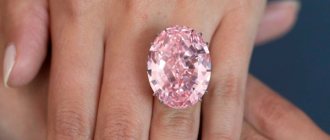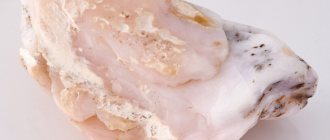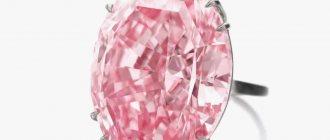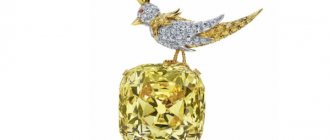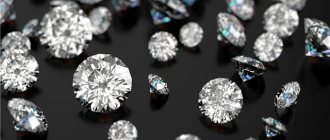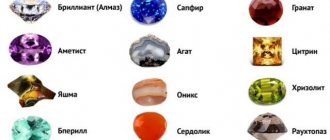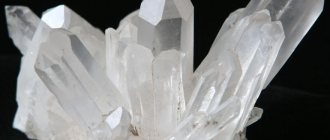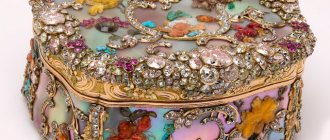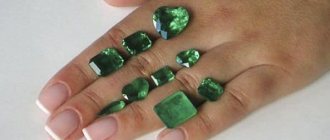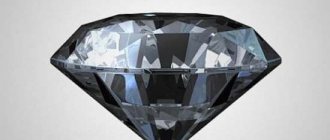These precious stones are not sold in jewelry stores and very rarely become auction lots. Their appearance is always a world sensation. The world's richest people lined up to buy a pink diamond. The next flamingo-colored diamond has not yet been found, but its future owner is already known. And it’s not just the rarity of such minerals.
Characteristics of Pink Diamond
In the past, colored diamonds were sold cheaper than colorless diamonds. It was believed that they contained impurities and were not full-fledged diamonds. After research, it turned out that the composition of a pink diamond is no different from its classic “brother.” Such specimens are found much less frequently, so the price for especially large and bright specimens is unusually high.
A crimson-colored diamond belongs to the fancy group. Their share in the total volume of diamonds is 1%. Pink diamonds are mined in only three countries - Australia, India and Brazil.
Sometimes they are found in Yakutia, but when cut, the delicate color mysteriously disappears, resulting in an ordinary transparent diamond. The most valuable samples are found on the Green Continent, at the Argyle deposit, and their processing is usually done there - in Perth.
In reality, the stone is not completely pink.
A delicate shade is observed only in some crystals of the mineral, the remaining areas are colorless. Numerous facets of a diamond intensely refract light rays, so the illusion arises that it is entirely colored.
Minerals acquire color due to impurities (lithium, iron, boron and others), the action of radiation, and the replacement of carbon atoms with nitrogen particles. There are no additives in a pink diamond; its structure has no specific differences.
The mystery of the color pink has not been solved. People can only admire these diamonds, consider them a unique creation of nature and pay exorbitant sums for the right to own such a miracle.
Not long ago, Rio Tinto, the owner of the Australian Argyle gold mine, made a statement that shocked lovers of fancy diamonds. He announced his intention to stop diamond mining at his field in 2022. This caused a stir in the diamond market and provoked a jump in prices for stones of all shades of red.
Research
Australian pink diamonds have been studied in detail at the molecular level many times. In an attempt to detect the presence of impurities that affect the pink color of a diamond, scientists subject the stones to mass spectrometric analysis. As a result of the studies, no impurities were found. Spectrometric measurements fully confirmed this conclusion.
Another interesting experiment was carried out. The diamond was exposed to a focused ion beam, resulting in a depression in its surface. Scientists extracted silver from it, which they also subjected to research. The result was the discovery that the diamond was not completely pink, but fragmentary. Geologists call this phenomenon twin planes and argue that they are the result of volcanic activity.
The mystery of the fantasy shade
Where pink samples came from in the family of colorless diamonds remains a mystery to this day. Scientists have not yet found an exact answer to this question. There are four points of view regarding the origin of such minerals in the scientific world:
- Shock therapy. The most popular hypothesis is that pink diamonds originated from volcanic eruptions. Sometimes this process is accompanied by the formation of special igneous rocks - lamproites. They contain amazing purple or powdery diamonds.
- Action of high temperatures and pressure. Most geologists are inclined to believe that it was these factors that gave rise to the appearance of “ruddy” diamonds, and the process of their formation took thousands of years.
- Manganese. When a diamond is “born,” microscopic dust particles of manganese or ferrous compounds enter its structure. They give the mineral a salmon tint. To prove this theory, gemologists subjected the gems to careful study. The experiments carried out neither confirmed nor refuted this idea.
- Aliens from outer space. Some mineralogists suggest that pink-colored diamonds “fell from the sky.” On its way to Earth, the falling meteorite, as a result of friction with the dense layers of the atmosphere, became red-hot and turned into a diamond. The main argument in favor of this hypothesis is that the chemical composition of a diamond is pure carbon. This theory seems unlikely, so the number of its supporters is not very large.
Since the 70s of the last century, people have learned to grow diamonds artificially.
In appearance and characteristics, they copy natural diamonds 100%. Cultured stones, which are pinkish-orange in color, are much cheaper than natural specimens. Only wealthy people can purchase a synthetic “clone”. Such stones cost up to $3,000 per carat, but their purchase cannot be considered as a profitable financial investment. Only natural gems have value.
Production
The diamond, whose pink hue remains unique even with the development of modern technology, is mined in western Australia. The largest mine in the world is the Argyll mine. And even in this field it remains a rare find. In total, prospectors manage to find several diamonds of this shade per year.
Trying to uncover the secret of the pink color of diamonds, experts are looking for answers to many questions. Some of them are even connected with the history of the origin and development of our planet.
It is known that the formation of most diamonds began billions of years ago. By studying these stones, you can learn a lot about the history of the Earth, since they are a kind of “time capsule”.
Color saturation
Diamonds in red colors are extremely rare, and among them no two are identical in hue and color saturation. The most expensive diamond is considered to be a bright pink one. Excessively light and dark specimens are valued lower because they do not look as impressive.
Jewelers rate the color of a fancy stone on a 9-point scale: from pale to deep red. The most expensive in this family are red diamonds.
The highlight of the Argyle Pink Dimond Tender 2017 auction was a sparkling “baby” of 2.11 ct, faceted with a radiant. A diamond called the Argalian Eternally Shining was obtained from a 4.38 ct diamond. This is the only bright red diamond in the history of Rio Tinto weighing more than two carats.
Based on color saturation, the following varieties of dawn-hued diamond are distinguished:
- Very Intense - very rich.
- Intense - saturated.
- Strong – bright.
- Medium – moderately saturated.
- Medium Light – medium brightness.
- Faint – dull.
There are 20 shades of pink diamond. Primary colors:
- Purplish Pink (PP) – purple.
- Pink Champagne (PC) – pink champagne.
- Brownish Pink (BR) – pink-brown.
Crystal clear natural diamonds are rare.
The cost of such rarities is expressed in millions of dollars. Usually the mineral contains impurities that give it a tint. A pink diamond, which has a violet or orange tint, is valued higher than pale variations on the pink theme with yellow and brown tints.
Countries of origin
Diamonds of this color are rarely found even at auctions. The reason for this is the small number of places where they can be found.
There are only three countries where discoveries of pink diamonds were previously registered:
- Brazil;
- India;
- Australia.
These minerals are most often found in Australia in the Argyle diamond mine, which is owned by Rio Tinto. Next year the owner plans to stop operating the mine, which is why diamond prices have increased many times over. Read more about diamond mining →
Quality criteria
To determine the quality of fancy colored diamonds, as well as classic uncolored diamonds, the rule of four Cs is used. The beauty and value of a stone are assessed according to the following parameters:
- Purity. The more transparent the diamond, the brighter it plays and shimmers in the light. Some people believe that the inclusions found in colored diamonds are less noticeable. Indeed, the pink tint hides the presence of inclusions, but only the tiniest ones. If the stone has minor defects that are visible under magnification, this will still negatively affect its value. Purity is assessed in the range from 1 to 4 (according to the American classification - VS, VVS, SI1, SI2) - from the most transparent to a mineral with defects that can be seen with the naked eye.
- Color. Pink diamonds are unique and are sold in single copies. The gemstone costs $80 thousand per carat, and sometimes the price reaches $1 million. Each of these diamonds has a certificate issued by an independent gemological laboratory. It indicates whether the mineral has been subjected to “refinement” - a technological operation as a result of which its natural color has become more saturated and even. If the shade and brightness of the stone have been artificially adjusted, then its cost should be lower.
- Cut. When assigning a category to a diamond (from highest to commercial), experts evaluate not only the natural characteristics of the nugget. Great importance is attached to how masterfully the cut is performed. The cutter's skill fully reveals the luxury of a fancy diamond, making it sparkle and scatter with myriads of silvery-pink sparks. Jewelers have a special attitude towards colored diamonds. They are cut according to different rules, because light is refracted differently in a “colored” stone than in a colorless one.
- Weight. The weight of precious stones is measured in carats: 1 ct = 0.2 g. After cutting, the weight of the nugget decreases several times. Jewelers ruthlessly cut off the excess to give the diamond ideal proportions and dazzling shine. Finding a diamond larger than 5 carats is a real success, especially if we are talking about a pink crystal.
The best settings for pink diamonds are white gold and platinum. Such noble metals do not distract attention, but only shade and emphasize the exquisite color of the stone.
Famous specimens
A pink diamond is a rare thing in itself, so almost every piece can be called famous. Among the most famous stones:
- pink Graff - named after the jeweler who purchased it at Sotheby's for $46 million;
- pink Clark - belonged to New York millionaire Huguette Clark, its cost is almost 16 million dollars;
- Tudor rose - 1 carat;
- Queen - 2 carats;
- Beauty of the East - 5 carats;
- Steinmetz Pink - mined in South Africa, weight 59.6 carats.
All these diamonds are in private collections.
To watch the video from the auction:
pink star
A stone called “Pink Star” was auctioned at Sotheby’s in 2013. It was purchased by an unknown person at a cost of $83 million. A year later it became known that the buyer was unable to pay this amount. The nugget weighing 59.6 carats was purchased at the auction itself at a price of $72 million. This is the largest and most expensive purple diamond to date.
Pink Panther
Another extraordinary representative of purple nuggets. Its weight is 5 carats and its value is estimated at $11 million. It has a unique multifaceted shape and is distinguished by high purity. The stone is set on a white gold ring.
Martian pink stone
Sold to an unknown buyer, there is still no information about its whereabouts. The mineral has the shape of a circle and weighs 12 carats. It received its name in honor of the space expedition to Mars sent by NASA in 1976.
Darya-e-Noor
The name of this diamond is translated as “river of light” or “sea of light.” Its weight is 186 carats. It has a pale tint, which is the rarest. It is believed that the nugget from which the diamond was cut was mined in India in the 18th century.
At first it was owned by the Shahs of Persia. The stone was set in a gold frame and was a symbol of the Shah's Iran. After the overthrow of the last Iranian Shah, Reza Pahlavi, the diamond was placed in the National Bank of Iran.
Noor Ul Ain
The name translates as "Eye of Light". Found in India in the early 18th century. After the capture of the country by Nadir Shah, he was taken to Persia. In the 20th century, it was cut into an oval shape, and the weight of the stone began to be 60 carats. Today it is located in the National Bank of Iran. The diamond occupied a central place in the crown of the Iranian queen Farah Diba.
Diamond jewelry
Pink diamonds are used to make jewelry that are works of art:
- “The perfect Pink” - a 14.2-carat stone is set in a white gold ring, flanked by white diamonds. The perfect pink nugget is cut into a rectangle shape. Sold at a Chinese auction.
- The Vivid Pink of Graff ring is made of white gold. It was decorated with the Clark diamond. The cost of the decoration is almost 16 million dollars.
- The next ring has no name. It was presented by the famous singer Enrique Iglesias to the no less famous tennis player Anna Kournikova. The price of the jewelry is $11 million.
Jewelry with purple diamonds is not worn for show. This is an investment of money; the value of such works only increases over time.
View this post on Instagram
Publication from Lombard CORONA Surgut (@lombard_korona) February 19, 2019 at 3:49 PST
How to purchase and how much does it cost?
One thing is for sure, you can’t buy such a product in a store. Recently, those who want to get this miracle of nature into their collection have been lining up even before the diamond is discovered. Once it is found in nature, the owner is already known. This kind of purchase is much more expensive, but true connoisseurs believe that it is worth it. Some pink diamonds don't even make it to auction.
But still, items with stones of such a rare shade periodically appear at auctions, and then the fight for it begins. A diamond is a sign of wealth, and getting such a jewel is very important for people of high rank, because it is a sign of privilege.
If we talk about the price, it is very high. The average price per carat is now $80,000. But when this diamond is put up for auction, those who want to purchase it are ready to pay many times more. Depending on the quality of the product, the price per carat can rise to a million dollars. The record amount paid for such a diamond is $72 million.
